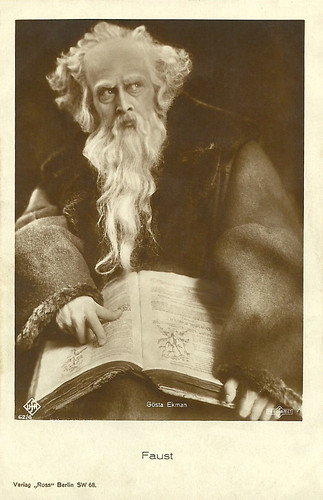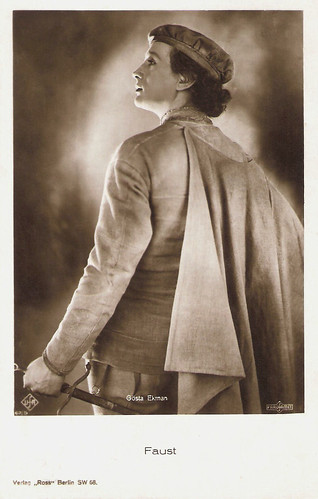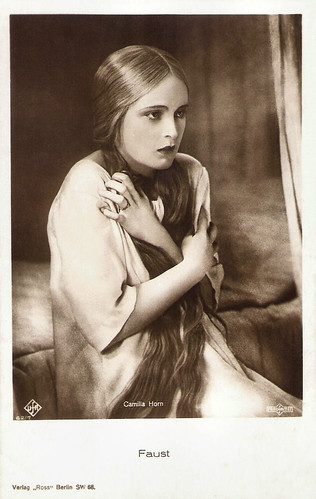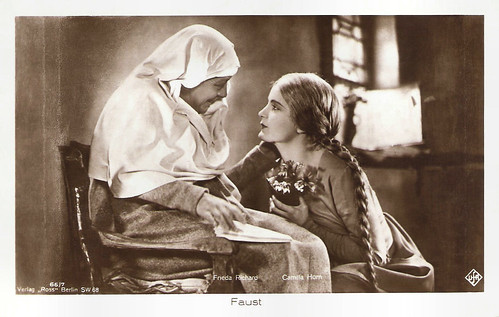
German postcard by Ross Verlag no. 1806/1, 1927-1928. Photo: Ufa.

German postcard by Ross Verlag, no. 1942/2, 1927-1928. Photo: Ufa.
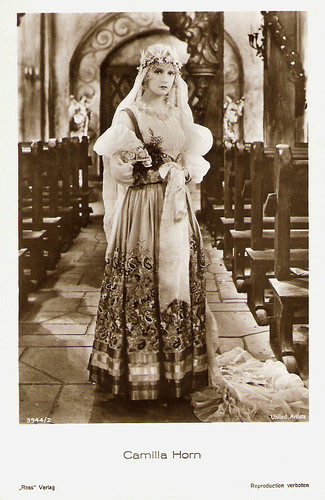
German postcard by Ross Verlag, no. 3944/2, 1928-1929. Photo: United Artists.

German postcard by Ross Verlag, no. 3154/1, 1928-1929. Photo: Atelier Binder, Berlin.
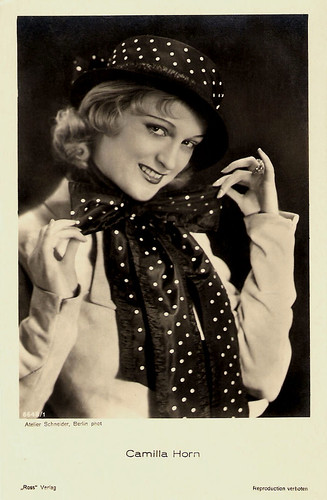
German postcard by Ross Verlag, no. 6648/1, 1931-1932. Photo: Atelier Schneider, Berlin.
Dancer in a cabaret
Camilla Martha Horn was born in Frankfurt am Main, Germany, in 1903. She was the daughter of the railway official Wilhelm Horn and his wife Martha.
After passing an examination as a seamstress, Horn initially worked in various professions to finance her acting training. She finally completed her training in Berlin with Lucie Höflich and also took dance lessons with Rudolf von Laban.
Horn made her stage debut as a dancer in a cabaret. Her film debut was in the Alexandre Dumas père adaptation Kean (Rudolph Biebrach, 1921). In the following years, she had a few appearances as an extra.
In 1925, she worked as an extra in Madame wünscht keine Kinder/Madame Doesn't Want Any Children (Alexander Korda, 1925) with Marlene Dietrich.
In Murnau's Molière adaptation Tartüff/Tartuffe (Friedrich Wilhelm Murnau, 1925), she was a double for the female star, Lil Dagover.
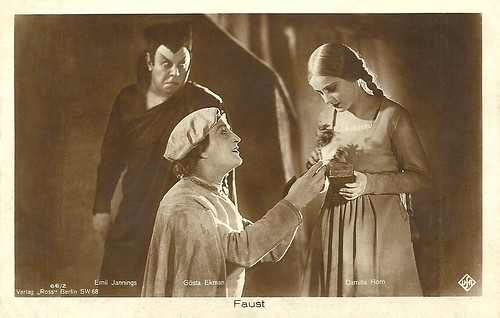
German postcard by Ross Verlag, no. 66/2. Photo: Ufa. Gösta Ekman, Emil Jannings and Camilla Horn in Faust (1926). Collection: Didier Hanson.
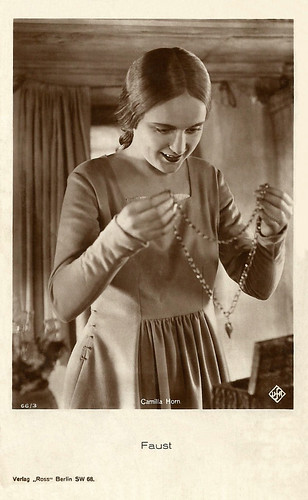
German postcard by Ross Verlag, no. 66/3. Photo: Ufa. Publicity still for Faust (Friedrich Wilhelm Murnau, 1926).
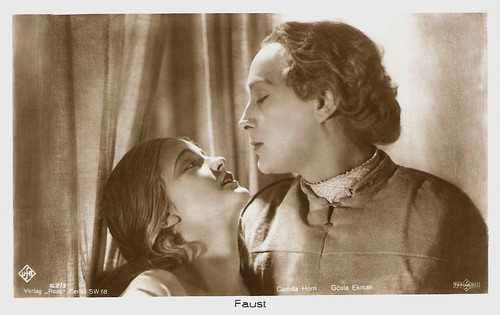
German postcard by Ross Verlag, no. 62/3. Photo: Parufamet. Publicity still for Faust (Friedrich Wilhelm Murnau, 1926).
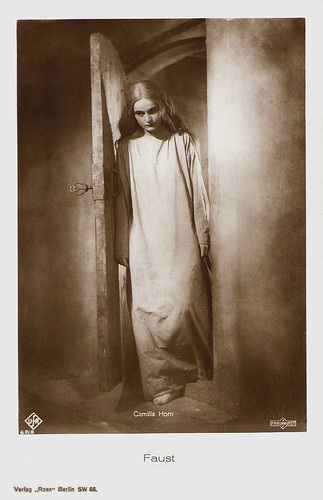
German postcard by Ross Verlag, no. 62/8. Photo: Parufamet. Publicity still for Faust (Friedrich Wilhelm Murnau, 1926).

German postcard by Ross Verlag, no. 66/6. Photo: Ufa. Publicity still for Faust (Friedrich Wilhelm Murnau, 1926).

Austrian postcard by Iris Verlag, no. 868. Photo: Kiesel, Berlin.
Ideal casting
Camilla Horn's great chance came when director Friedrich Wilhelm Murnau prepared a film version of Goethe's 'Faust'.
Murnau had asked Hollywood star Lillian Gish to play Gretchen in the lavish Ufa production, but she insisted that the film should be shot by her favourite cinematographer, Charles Rosher.
Therefore, Murnau decided to cast the newcomer he had met on the set of Tartüff/Tartuffe (Friedrich Wilhelm Murnau, 1925) would play Gretchen opposite Gösta Ekman as Faust and Emil Jannings as Mefisto.
The completely unknown Horn proved to be the ideal casting for the role of the ill-fated Gretchen and Faust (Friedrich Wilhelm Murnau, 1926) made her a star.
She signed a four-year contract with the Ufa and acted in Jugendrausch/Youth Frenzy (Georg Asagaroff, Wladyslaw Starewicz, 1927) and Der fröhliche Weinberg/The Merry Weinberg (Jacob Fleck, Luise Fleck, 1927).

Austrian postcard by Iris Verlag, no. 5943. Photo: Distr. Allianz-Film / Excelsior-Film.

German postcard by Ross Verlag, no. 4449/1, 1929-1930. Photo: Atelier Schrecker, Berlin.
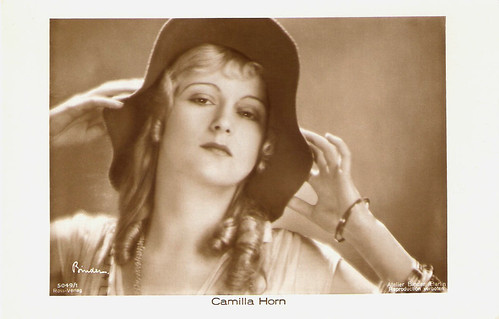
German postcard by Ross Verlag, no. 5049/1, 1930-1931. Photo: Atelier Binder, Berlin.
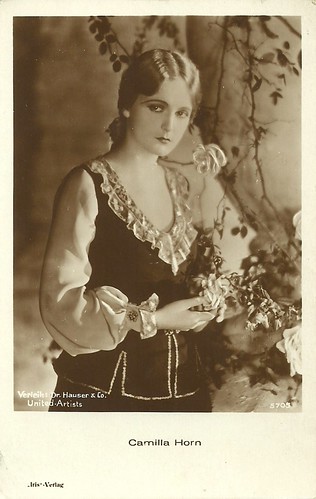
Austrian postcard by Iris Verlag, no. 3705. Photo: Verleih Dr. Hauser & Co. / United Artists.
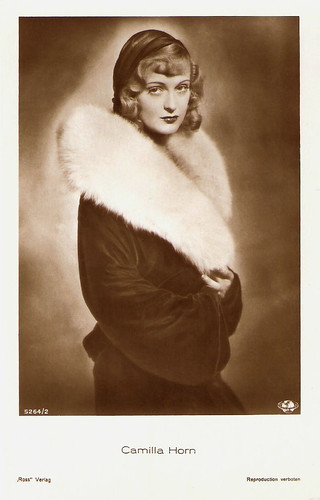
German postcard by Ross Verlag, no. 5264/2, 1930-1931. Photo: Deutsche Universal.

German postcard by Ross Verlag, no. 7916/2, 1932-1933. Photo: Gerstenberg-Dührkoop, Berlin.
Monetary offence
In 1928 Camilla Horn sailed for Hollywood where she became the mistress of producer Joseph Schenck and played in two United Artists productions. She starred in Tempest (Sam Taylor, 1928) and Eternal Love (Ernst Lubitsch, 1929) both opposite John Barrymore. Eternal Love was the last silent film of Barrymore and director Lubitsch. Filmed on location in the Canadian Rockies, Eternal Love was a most uncharacteristic venture into doom and gloom for Lubitsch
She returned to Europe and made popular films like Die grosse Sehnsucht/The Great Desire (Steve Sekely, 1930) and Hans in allen Gassen (Carl Froelich, 1930) with Hans Albers. In Great Britain, she appeared in the Comedy of Errors, The Love Nest (Thomas Bentley, 1933), set during a dark and stormy night and the murder mystery Matinee Idol (1933), directed by George King.
In Germany, Camilla Horn appeared in Moral und Liebe/Morals and Love (Georg Jacoby, 1933), Die grosse Chance/The Big Chance (Victor Janson, 1934), and Ein Walzer für dich/A Waltz for You (Georg Zoch, 1934).
In the next years, she starred in Der rote Reiter/The Red Rider (Rolf Randolf, 1935), Gauner im Frack/crook in Tails (Johannes Riemann, 1938) and Fahrendes Volk/Driving People (Jacques Feyder, 1938) again at the side to Hans Albers.
She refused to follow the official line of the Nazis and was prosecuted for a monetary offence. During the war, she got only minor parts or she acted in Italian productions like Paura d'amare/Fear of Loving (Gaetano Amata, 1942).

German postcard by Ross Verlag, no. 4845/1, 1929-1930. Photo: Alex Binder, Berlin.

German postcard in the Ross Luxus series by Ross Verlag, Berlin, no. 673. Photo: Ufa.
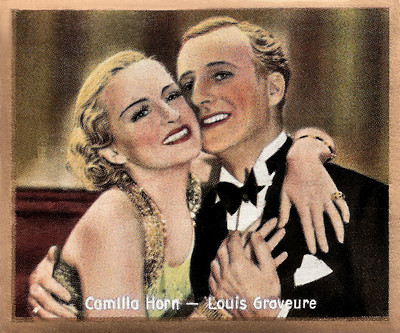
German collectors card by Ross Verlag for Cigarettenfabrik Josetti, Berlin, in the series 'Unsere Bunte Filmbilder', no. 115. Photo: Badal-Film. Camilla Horn and Louis Graveure in Ein Walzer für dich/A Waltz for You (Georg Zoch, 1934).

German postcard by Ross Verlag, no. 588. Photo Atelier Balazs, Berlin.

British postcard in the Filmshots series by Film Weekly. Photo: British International Pictures (BIP). Camilla Horn and Gene Gerrard in The Love Nest (Thomas Bentley, 1933).

German postcard by Ross Verlag, no. 9129/2, 1935-1936. Photo: Atelier Yva, Berlin.
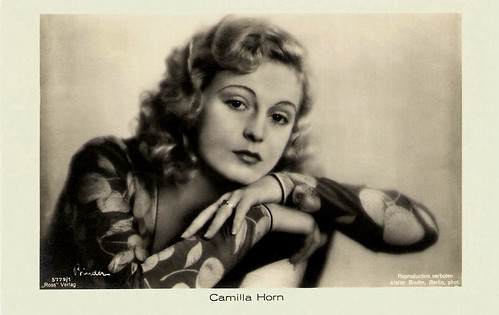
German postcard by Ross Verlag, Berlin, no. 5779/1, 1930-1931. Photo: Atelier Binder.
Late comeback
After the war, the British tribunal at Delmenhorst convicted Camilla Horn for minor offences (among them travelling without permission) and she was imprisoned for three months at the women's prison in Vechta. Her knowledge of English led her to work first as an interpreter and then again as an actress on stage. The German cinema of the post-war years offered her only rare roles in films like Königin der Arena/Queen of the Arena (Rolf Meyer, 1952) and Vati macht Dummheiten/Daddy Does Dumb (Johannes Häussler, 1953).
Camilla Horn appeared only a few times on German television. An example was Mrs. Elizabeth Almond in Die Erbin (1958) based on the play 'The Heiress' by Ruth and Augustus Goetz, based on the novel 'Washington Square' by Henry James. Willy Birgel played doctor Dr. Austin Sloper and Elfriede Kuzmany was his daughter Catherine. In later years she appeared for example as Mrs. Rens, mother of Dr. Rens (Holger Petzold) in the episode 'Die Wunderquelle' (1985) from the cult series 'Die Schwarzwaldklinik'. In 1985 she wrote her memoir, 'Verliebt in die Liebe'.
In the cinema, she made a comeback in Schloss Königswald/Castle Königswald(Peter Schamoni, 1988), an hommage to former film stars like Camilla Horn, Marianne Hoppe, Carola Höhn, Marika Rökk and Rose Renée Roth. They played elderly female aristocrats who gathered at an ancient castle to live in grand style and escape the chaos of World War II. The all-star cast was awarded the Bavarian Film Award for Best Actress of 1988.
Her last appearance was in the TV drama Die Spinnen/The Spiders (Pál Erdöss, 1989) with Mark Bellinghaus. She was unable to fulfil her last commitment, to play the role of Miss Sophie in the 1992 feature film Dinner for One with Bodo Maria, due to illness. A video was made dedicated to her. She spent her old age at Herrsching, and during the last year of her life, she lived in Gilching near Starnberg, where she had lived.
Camilla Horn died in Gilching, Germany, in 1996. Her grave is in the cemetery in Herrsching am Ammersee. She was married four times: to the businessman Klaus Geerts (1927 to 1930), to the architect Kurt Kurfis (from 1938), to the Swiss Robert Schnyder and to Rudolf Mühlfenzl, the editor-in-chief of Bayerischer Rundfunk (1953 to 1963). She owned a weekend house in the 1930s in Lübben (Spreewald) on the Weinberg, which still stands today.

German postcard by Ross. Photo: Terra-Baumann.
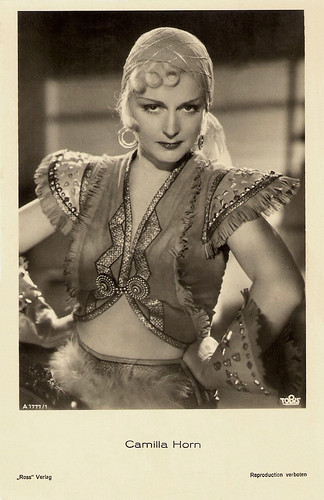
German postcard by Ross Verlag, no. A 1777/1, 1937-1938. Photo: Tobis. Camilla Horn in Fahrendes Volk/People Who Travel (Jacques Feyder, 1938).

German postcard by Ross Verlag, no. A 1961/1, 1937-1938. Photo: Haenchen / Tobis.

German postcard by Das Filmprogramm von Heute. Zeitschrift für Film und Theater. Photo: Tobis.
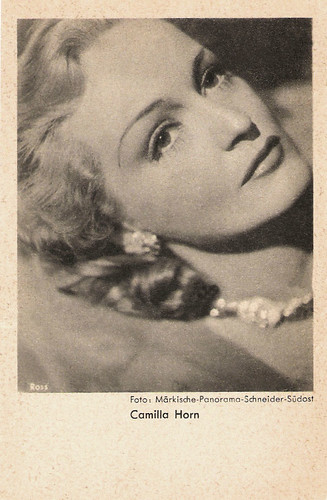
German postcard by Ross / Das Programm von Heute, Berlin. Photo: Märkische - Panorama - Schneider - Südost.

German postcard by Ross Verlag, no. A 3317/2, 1941-1944. Photo: Baumann / Terra. Camilla Horn in Friedemann Bach (Traugott Müller, Gustaf Gründgens, 1941).

German postcard by Film-Foto-Verlag, no. A 3792/1, 1941-1944. Photo: S.A. Bertazzini.
Sources: Thomas Staedeli (Cyranos), Hal Erickson (AllMovie - page now defunct), Stephanie d'Heil (Steffi-Line - German), Wikipedia (English, and German ), IMDb.
This post was last updated on 19 October 2024.

